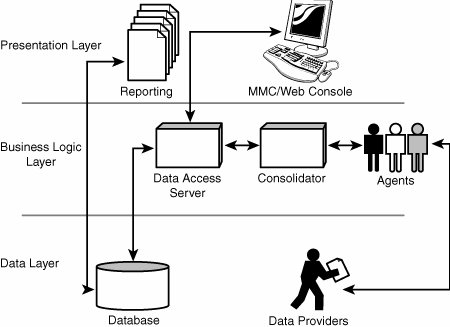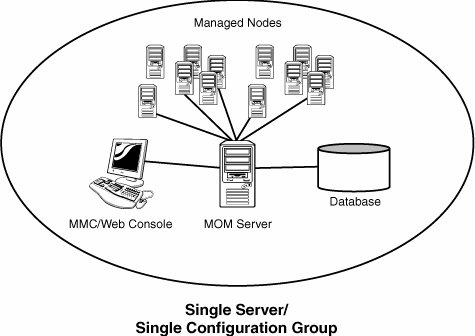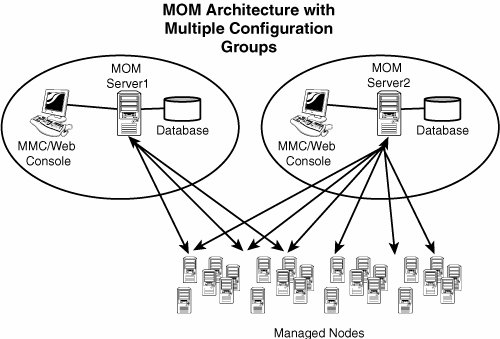Outlining MOM Architecture
| MOM is primarily composed of four basic components: the database, data access server, consolidator/agent manager, and MOM agents. MOM was specifically designed to be scalable and can subsequently be configured to meet the needs of any size company. This flexibility stems from the fact that all MOM components can either reside on one server or can be distributed across multiple servers. Microsoft separates the components into a distributed multitier architecture based on the standard network OSI model, condensed into the Presentation, Business Logic, and Data layers, in this case. Each layer of the model corresponds with MOM components, as illustrated in Figure 25.1. Figure 25.1. The Microsoft Operations Manager architecture. The MOM administrator console, Web console, and the Reporting feature make up the Presentation Layer components. The consolidator/agent manager, data access server, and agents make up the Business Logic layer. Lastly, the database and data providers comprise the Data layer. Each of these various components provides specific MOM functionality. MOM design scenarios often involve the separation of parts of these components onto multiple servers. For example, the database component can be delegated to a dedicated server, and the data access server and consolidator can reside on a second server. More details on these concepts can be found in the "Identifying Sample Designs of Successful MOM Implementations" section later in this chapter. How MOM Stores Captured DataMOM utilizes a Microsoft SQL Server database as the central repository for all collected data. This data includes all event log and performance data gathered from each managed computer. The database also stores all the scripts used by the management pack rules. This database must be installed as a separate component from MOM but can physically reside on the same server, if needed. Proper SQL procedures and maintenance for this database component are critical for proper MOM functionality. Note For testing purposes, an MSDE database can be used with MOM to provide for MOM's database needs. However, it is highly recommended that a full SQL database be used in a production environment, as there are several restrictions associated with the MSDE database. The Role of the Data Access ServerThe data access server (DAS) is the MOM component that is used to communicate with the MOM database. It handles all the data transactions between the database and all the other MOM services. Most requests to read information from the database use DAS (with the major exception of Reporting), as well as all requests to write data to the database. The Consolidator ComponentThe consolidator is responsible for controlling and updating all the managed computers in a MOM database. It delivers all client agent updates, which include updating any rules or configuration settings to the managed computers. It also delivers all data gathered by the managed computers to the DAS. Determining the Role of Agents in System MonitoringThe agents are the monitoring components installed on each managed computer. They use the collected event logs and performance counter data and process them based on the management pack rules installed on the computer. Creating Administrative Boundaries with Configuration GroupsMOM utilizes the concept of configuration groups to logically separate geographical and organizational boundaries. Configuration groups allow administrators to scale the size of MOM architecture or politically organize the administration of MOM. Each configuration group consists of the following components:
As noted in the "Identifying Sample Designs of Successful MOM Implementations" section later in this chapter, MOM can be scaled to meet the needs of different sized organizations. For small organizations, all the MOM components can be installed on one server with a single configuration group, as illustrated in Figure 25.2. Figure 25.2. Single configuration group. In large organizations, on the other hand, the distribution of MOM components to separate servers allows the organizations to customize their MOM architecture, as illustrated in Figure 25.3. Multiple configuration groups provide load balancing and fault tolerance within the MOM infrastructure. Organizations can set up multiple consolidators, data access servers, or agent managers at strategic locations, to distribute the workload between them. Figure 25.3. Multiple configuration groups. Note The general rule of thumb with configuration groups is to start with a single configuration group and add on more configuration groups only if they are absolutely necessary. Administrative overhead is reduced, and there is less need to re-create rules and perform other redundant tasks with fewer configuration groups. |
EAN: 2147483647
Pages: 499


